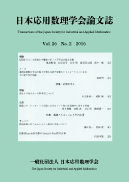Volume 23, Issue 1
Displaying 1-15 of 15 articles from this issue
- |<
- <
- 1
- >
- >|
-
Article type: Cover
2013 Volume 23 Issue 1 Pages Cover1-
Published: March 25, 2013
Released on J-STAGE: April 08, 2017
Download PDF (10647K) -
Article type: Cover
2013 Volume 23 Issue 1 Pages Cover2-
Published: March 25, 2013
Released on J-STAGE: April 08, 2017
Download PDF (10647K) -
Article type: Appendix
2013 Volume 23 Issue 1 Pages App1-
Published: March 25, 2013
Released on J-STAGE: April 08, 2017
Download PDF (27K) -
Article type: Article
2013 Volume 23 Issue 1 Pages A1-
Published: March 25, 2013
Released on J-STAGE: April 08, 2017
Download PDF (143K) -
Article type: Appendix
2013 Volume 23 Issue 1 Pages i-x
Published: March 25, 2013
Released on J-STAGE: April 08, 2017
Download PDF (543K) -
Article type: Article
2013 Volume 23 Issue 1 Pages 1-13
Published: March 25, 2013
Released on J-STAGE: April 08, 2017
Download PDF (780K) -
Article type: Article
2013 Volume 23 Issue 1 Pages 15-35
Published: March 25, 2013
Released on J-STAGE: April 08, 2017
Download PDF (1223K) -
Article type: Article
2013 Volume 23 Issue 1 Pages 37-54
Published: March 25, 2013
Released on J-STAGE: April 08, 2017
Download PDF (1038K) -
Article type: Article
2013 Volume 23 Issue 1 Pages 55-107
Published: March 25, 2013
Released on J-STAGE: April 08, 2017
Download PDF (3584K) -
Article type: Article
2013 Volume 23 Issue 1 Pages 109-181
Published: March 25, 2013
Released on J-STAGE: April 08, 2017
Download PDF (4198K) -
Article type: Appendix
2013 Volume 23 Issue 1 Pages App2-
Published: March 25, 2013
Released on J-STAGE: April 08, 2017
Download PDF (53K) -
Article type: Appendix
2013 Volume 23 Issue 1 Pages App3-
Published: March 25, 2013
Released on J-STAGE: April 08, 2017
Download PDF (53K) -
Article type: Appendix
2013 Volume 23 Issue 1 Pages App4-
Published: March 25, 2013
Released on J-STAGE: April 08, 2017
Download PDF (53K) -
Article type: Cover
2013 Volume 23 Issue 1 Pages Cover3-
Published: March 25, 2013
Released on J-STAGE: April 08, 2017
Download PDF (28K) -
Article type: Cover
2013 Volume 23 Issue 1 Pages Cover4-
Published: March 25, 2013
Released on J-STAGE: April 08, 2017
Download PDF (28K)
- |<
- <
- 1
- >
- >|
